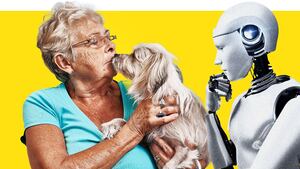The Baby Boomer generation represents one of the largest generational groups in America. As they age into stages of life that require more assistance, fewer caregivers are available to support this larger base of folks in need.
The caregiving process has proven to be a double-edged sword—providing indispensable attention to people who may otherwise not receive it but effectively exhausting the caregiver, most of whom are often family members.
“Over the next 15 years, we’re going to be supporting the 80 million people that are transitioning into retirement, into this vulnerable age category which puts you at risk for chronic health conditions,” Briony Catlow, director of the University of Denver’s Knoebel Institute for Healthy Aging, told The Daily Beast.
“We already know the cost, in terms of people’s emotions, relationships, loss, how that affects us as people as well as the financial cost to families, to governments, to insurance companies, to the health-care system, that chronic health conditions produce,” she added.
According to the National Investment Center for Seniors Housing and Care, senior care facilities in America can expect to see nearly quadruple the number of patients that they currently hold as the baby boomer generation ages. Life expectancy for those who are 65 and older has also increased from prior decades as medical sciences continue to advance.
By 2040, the U.S. Census Bureau estimates that the entire baby boomer generation will be 75 or older. Still, there is a dwindling supply of caregivers for seniors and those living with disability, the populations that utilize assisted living centers more than any other.
A study published in the journal Health Affairs found that the number of Medicaid home health-care workers—nurses who visit patients at their residence rather than within a care facility—shrunk in the U.S. by nearly 12 percent from 2013 to 2019, despite the number of Medicaid home and community-based program participants growing by nearly 60 percent in that same time period.
The Rosalynn Carter Institute for Caregivers found that about 1 in 5 employed caregivers also serves as an unpaid caregiver for a loved one, adding attrition and burnout from an exhausting, laborious job.
Enter RYAN—short for Robot You Always Need—born and raised in the University of Denver’s robotics lab. The DU robotics department is engaged in different arms of social robotics study, one being how to integrate robots such as RYAN at retirement homes.

RYAN is designed to aid older adults suffering from social isolation. The robot sports a customizable, slightly cartoonish face thanks to internal image projection within the robot’s head and can engage users with a bevy of games, music, conversations, and even yoga lessons.
Dilpreet RajuProfessor Mohammad Mahoor, director of the computer vision and social robotics laboratory, is focused on building robots to assist caregivers by interacting with older adults experiencing depression.
“We came up with seven different customer segments but at the end of the day we realized that senior care facilities, that’s a big market,” Mahoor told The Daily Beast. “We can have an impact there.”
RYAN is designed to aid older adults suffering from social isolation. The robot sports a customizable, slightly cartoonish face thanks to internal image projection within the robot’s head and can engage users with a bevy of games, music, conversations, and even yoga lessons.
Mahoor launched DreamFace Technologies in 2014. Since then, he has tested iterations of RYAN at local care facilities before recently moving to lease models out to care centers in and around Denver.
“That's really important, making sure that our programming is diverse,” Jennifer Ramirez, life enrichment coordinator at MorningStar at Observatory Park in Denver, the first senior care center to host a RYAN bot for the community, told The Daily Beast MorningStar first received the robot in June. Their RYAN sits in a communal room and sees a lot of attention daily.
“Something that's important to the residents is engaging conversation and just being informed—a lot of residents are very interested and want to continue to learn, and RYAN is definitely an example of that,” she explained.
Steve Auten, a resident at a different senior care facility not far from the University of Denver, was one of the first to interact with RYAN for an extended period of time. For more than two months, the 76-year-old Auten—who keeps himself busy by caring for his rescue terrier named Hay—hosted RYAN in his apartment by playing games of chess and listening to the AI script crack jokes.
“RYAN was nice to have around. He was always positive, cheerful. He was just a lot of fun,” Auten said.
RYAN, whose purpose is social interaction and social stimulation, stayed in Auten’s living room and started each day by saying good morning to Auten. He said the trial was a nice experience that he would welcome again.
“I would get him to respond,” Auten said. He also noticed how RYAN would remember details Auten relayed to the robot and then use them in conversation.

By 2040, the U.S. Census Bureau estimates that the entire baby boomer generation will be 75 or older. Still, there is a dwindling supply of caregivers for seniors and those living with disability, the populations that utilize assisted living centers more than any other.
Dilpreet RajuBased on the success of these trials, Mahoor and his team have been fabricating new versions of the robot in their campus lab. The fourth version of RYAN is underway and Mahoor says the aim is for mass production.
“We want to broaden the space of robot design,” Kerstin Haring, University of Denver assistant professor and director of the Human Robot Technology Lab, told The Daily Beast.
Most commonplace robots are being produced by corporations like Amazon and Boston Dynamics who have an advantage in funding and research, but are often monolithic in their representation.
“They're putting together this robot and the design decisions are made there, so when we look at that set of people, chances are that it's not very diverse,” she said. “We want to change that a little bit so that we have, at least, a broader demographic.”
Haring, who is not a part of the RYAN team, said that apart from large tech businesses, the most common space to find people working on developing more effective robots is at “academic institutions where it's, take your pick: robotics, engineering, computer science departments.”
Haring and Mahoor both stress that robots are not here to solve our bigger problems, they are here to supplement humans who could use a bit more help. While there is a perception that one day robots will become do-it-all machines—perhaps for seniors in need of care, for example—such a reality isn’t one to aspire for, Haring said.
“They don't solve our societal problems. They don't solve our socioeconomic problems, right? They're just tools,” Haring said. “They are an application that is being used, but it's not a solution.”

RYAN can remember details about patients and use them in "conversation."
Dilpreet RajuSome non-commercial, but still human-facing, robots in the form of physically assistive robotics have already shown promise. Zackory Erickson, Carnegie Mellon University assistant professor and lead of the Robotic Caregiving and Human Interaction Lab there, helps design robotics that aid folks living with physical impairments.
“We bring robots into the world to provide physical assistance to people with different types of conditions or diseases, whether that be due to neurodegenerative diseases or due to muscle atrophy, aging,” he told The Daily Beast.
The lab assesses “how can robots provide assistance for these things called activities of daily living to help people from eating food, getting dressed, to clean their body, things we have to do every day just to remain independent in our homes,” he said.
Erickson and his students have published research on an interface that can recognize head motions as a means to operate an assistive robot for people living with paralysis or amputation(s).
“We’re really starting to evaluate this technology out in the real world with populations that could benefit from it, there’s a lot of really positive reception that we've gotten thus far. Many of these individuals, the only other option they have is to ask the caregiver, which is often a family member or friend,” Erickson said.
As robots begin to enter assisted living facilities, there remains a long but promising road to seeing how robotics will become accessible tools for human caregivers to help ease their daily workload. Not only can these robots give time back to the caregivers, but they could also enhance the quality of life of the patients they’re helping.
While a robot is no replacement for its flesh-and-blood counterpart, they can help ease the workload—and lend a helping bionic hand to your grandparents.








